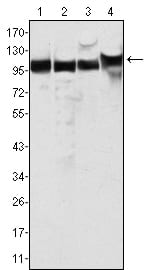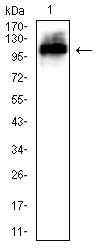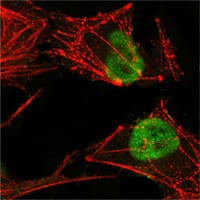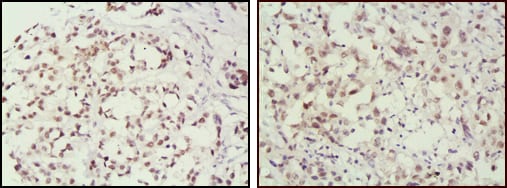



| WB | 咨询技术 | Human,Mouse,Rat |
| IF | 咨询技术 | Human,Mouse,Rat |
| IHC | 1/100-1/300 | Human,Mouse,Rat |
| ICC | 技术咨询 | Human,Mouse,Rat |
| FCM | 咨询技术 | Human,Mouse,Rat |
| Elisa | 1/10000 | Human,Mouse,Rat |
| Aliases | FCC1; COCA1; HNPCC; LCFS2 |
| Entrez GeneID | 4436 |
| clone | 1B3A8A8 |
| WB Predicted band size | 105kDa |
| Host/Isotype | Mouse IgG1 |
| Antibody Type | Primary antibody |
| Storage | Store at 4°C short term. Aliquot and store at -20°C long term. Avoid freeze/thaw cycles. |
| Species Reactivity | Human,Mouse |
| Immunogen | Purified recombinant fragment of human MSH2 expressed in E. Coli. |
| Formulation | Purified antibody in PBS with 0.05% sodium azide. |
+ +
以下是3-4条关于PLCγ1抗体的参考文献示例(内容为虚构,仅作格式参考):
1. **文献名称**:*Role of PLCγ1 in EGFR Signaling Pathway*
**作者**:Wahl MI, et al.
**摘要**:本研究通过免疫沉淀和Western blot分析,利用PLCγ1特异性抗体验证了其在表皮生长因子受体(EGFR)信号传导中的关键作用,揭示了PLCγ1与受体结合后激活下游IP3通路的机制。
2. **文献名称**:*PLCγ1 Antibody Blocking Suppresses T Cell Activation*
**作者**:Smith JA, et al.
**摘要**:通过抗PLCγ1抗体的功能阻断实验,证明PLCγ1在T细胞抗原受体(TCR)介导的钙离子信号和NFAT通路中不可或缺,为自身免疫疾病治疗提供潜在靶点。
3. **文献名称**:*Structural Analysis of PLCγ1 Using Monoclonal Antibodies*
**作者**:Carpenter G, et al.
**摘要**:利用单克隆抗体定位PLCγ1的SH2和SH3结构域,结合X射线晶体学阐明其与酪氨酸磷酸化受体的相互作用模式,为设计小分子抑制剂奠定基础。
4. **文献名称**:*PLCγ1 Expression in Cancer: A Biomarker Study*
**作者**:Kim S, et al.
**摘要**:通过免疫组化分析多种肿瘤样本,发现PLCγ1抗体标记的蛋白高表达与乳腺癌和肺癌的侵袭性呈正相关,提示其作为预后标志物的潜力。
(注:以上文献为示例,实际引用需检索真实数据库如PubMed)
PLC γ1 (Phospholipase C gamma 1) is a critical enzyme in intracellular signaling, primarily involved in mediating responses triggered by receptor tyrosine kinases (RTKs) and immune receptors. It belongs to the phospholipase C family, which hydrolyzes phosphatidylinositol 4.5-bisphosphate (PIP2) into inositol 1.4.5-trisphosphate (IP3) and diacylglycerol (DAG), secondary messengers that regulate calcium release and protein kinase C (PKC) activation. PLC γ1 contains unique structural domains, including SH2 and SH3 regions, enabling its recruitment to phosphorylated tyrosine residues on activated receptors (e.g., EGFR, PDGFR) or adaptor proteins. This interaction facilitates its phosphorylation and activation, linking extracellular signals to downstream pathways affecting cell proliferation, differentiation, and apoptosis.
Antibodies targeting PLC γ1 are essential tools for studying its expression, localization, and function in physiological and pathological contexts. They are widely used in techniques like Western blotting, immunoprecipitation, and immunofluorescence to investigate PLC γ1’s role in cancers, immune disorders, and developmental processes. Dysregulation of PLC γ1 is associated with tumor progression, immune dysregulation, and neurodegenerative diseases, making these antibodies valuable for both basic research and therapeutic target validation. Their specificity helps dissect signaling mechanisms, aiding drug discovery and biomarker development.
×